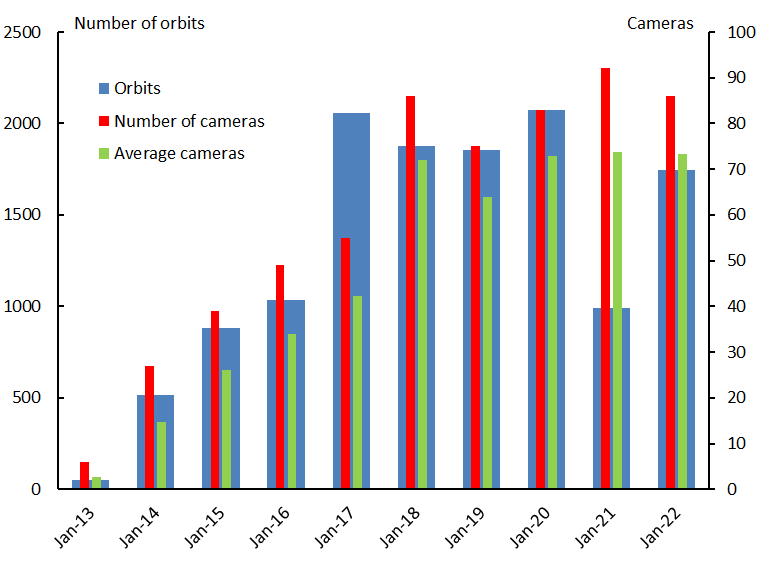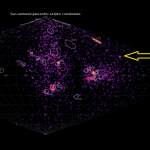Abstract: A summary of the activity of the CAMS BeNeLux network during the month of January 2022 is presented. This month gave many cloudy nights due to a persistent moisty type of weather. Especially the northern parts suffered from this weather, with sometimes 5 consecutive totally clouded nights. A total of 12018 meteors were registered of which 4741 multi-station meteors, good for 1744 orbits.
Introduction
Although there is approximately 15 hours of darkness in January in the BeNeLux, this month isn’t a month with high scores for our network. Meteor activity is still at a fairly good level, but weather isn’t cooperating most of the time. 2022 unfortunately wasn’t an exception.
January 2022 statistics
January 2022 was very mild, with a mean temperature above 5 degrees Celsius. This is not a good sign for astronomical observations. Observations of our network were hampered by clouds during many nights. Complete clear nights were very rare this month for most parts of the BeNeLux. Especially the northern parts of the BeNeLux saw many nights that were completely clouded out, sometimes 5 nights in a row as from January 11 – 16 and again from January 21 – 26.
Table 1 – Number of meteors per camera and number of meteors per camera per day for stations Hengelo (HL) and Mechelen (ML). RMS-data HL from CAMS 319 and 328.
| Hengelo (HL) | Mechelen (ML) | |||
| 8 Watecs | 2 RMS | 6 Watecs | 2 RMS | |
| Tot. meteors | 563 | 366 | 978 | 400 |
| Per Watec | 70.4 | 183.0 | 163.0 | 200.0 |
| Per night | 2.3 | 5.9 | 5.3 | 6.5 |
More southern parts were a bit luckier, but there too, many nights remained clouded or only partly clear nights. This has an effect on the efficiency of cameras on different sites in the BeNeLux. Table 1 gives data for two stations in our network. Hengelo (HL) in the northeastern parts of the Netherlands and Mechelen (ML) in the central part of Belgium. Both sites have Watecs and RMS-cameras that are working 7 nights on 7. But from Table 1 the disadvantage of Hengelo in collecting data this month, is clearly visible. As can be seen from this table, RMS cameras are more productive than Watecs, but in regions with much light pollution the difference seems not to be very large.

Figure 1 – Comparing January 2022 to previous months of January in the CAMS BeNeLux history. The blue bars represent the number of orbits, the red bars the maximum number of cameras running in a single night and the green bars the average number of cameras running per night.
Table 2 – January 2022 compared to previous months of January.
| Year | Nights | Orbits | Stations | Max. Cams | Min. Cams | Avg. Cams |
| 2013 | 7 | 49 | 6 | 6 | – | 2.6 |
| 2014 | 21 | 514 | 11 | 27 | – | 14.8 |
| 2015 | 22 | 880 | 14 | 39 | – | 26.1 |
| 2016 | 25 | 1037 | 15 | 49 | 10 | 34.0 |
| 2017 | 23 | 2058 | 18 | 55 | 18 | 42.3 |
| 2018 | 25 | 1878 | 22 | 86 | 53 | 72.1 |
| 2019 | 22 | 1857 | 20 | 75 | 54 | 64 |
| 2020 | 23 | 2075 | 21 | 83 | 64 | 72.9 |
| 2021 | 22 | 991 | 26 | 92 | 64 | 73.7 |
| 2022 | 28 | 1744 | 26 | 86 | 65 | 73.2 |
| Total | 218 | 13083 |
CAMS BeNeLux collected 12018 meteors of which 4741 or 39% multi-station meteors this month, resulting in a total of 1744 orbits, mainly from more southern locations in some clear spells. On the other hand, we had only three nights with no orbit at all this month.
As a consequence of the variable circumstances, nearly 60% of our orbits were derived from only two stations which is a fairly high number.
The lack of totally clear nights is the explanation for these numbers. For instance, the station of Hengelo, the Netherlands, had 13 fully clouded nights despite 7 on 7 coverage. At Mechelen, Belgium, only 4 nights were fully clouded this month.
Conclusion
The results for January 2022 are the fifth best during 10 years of CAMS BeNeLux.
Acknowledgment
Many thanks to all participants in the CAMS BeNeLux network for their dedicated efforts. The CAMS BeNeLux team was operated by the following volunteers during the month of January 2022:
Hans Betlem (Woold, CAMS 3071, 3072 and 3073), Jean-Marie Biets (Wilderen, Belgium, CAMS 379, 380, 381 and 382), Ludger Boergerding (Holdorf, Germany, RMS 3801), Martin Breukers (Hengelo, Netherlands, CAMS 320, 321, 322, 323, 324, 325, 326 and 327, RMS 319, 328 and 329), Giuseppe Canonaco (Genk, RMS 3818, RMS 3819), Pierre de Ponthiere (Lesve, Belgium, RMS 3816), Bart Dessoy (Zoersel, Belgium, CAMS 397, 398, 804, 805 and 806), Tammo Jan Dijkema (Dwingeloo, Netherlands, RMS 3199), Isabelle Ansseau, Jean-Paul Dumoulin, Dominique Guiot and Christian Walin (Grapfontaine, Belgium, CAMS 814 and 815, RMS 3814, RMS 3817), Uwe Glässner (Langenfeld, Germany, RMS 3800), Luc Gobin (Mechelen, Belgium, CAMS 3890, 3891, 3892 and 3893), Tioga Gulon (Nancy, France, CAMS 3900 and 3901), Robert Haas (Alphen aan de Rijn, Netherlands, CAMS 3160, 3161, 3162, 3163, 3164, 3165, 3166 and 3167), Robert Haas (Texel, Netherlands, CAMS 811, 812 and 813), Kees Habraken (Kattendijke, Netherlands, RMS 378), Klaas Jobse (Oostkapelle, Netherlands, CAMS 3030, 3031, 3032, 3033, 3034, 3035, 3036 and 3037), Carl Johannink (Gronau, Germany, CAMS 3100, 3101 and 3102), Reinhard Kühn (Flatzby, Germany, RMS 3802), Hervé Lamy (Dourbes, Belgium, CAMS 394 and 395), Hervé Lamy (Humain Belgium, CAMS 816), Hervé Lamy (Ukkel, Belgium, CAMS 393), Koen Miskotte (Ermelo, Netherlands, CAMS 3051, 3052, 3053 and 3054), Tim Polfliet (Gent, Belgium, CAMS 396, RMS 3820), Steve Rau (Zillebeke, Belgium, CAMS 3850, 3852, RMS 3851, RMS 3853), Paul and Adriana Roggemans (Mechelen, Belgium, RMS 3830 and 3831, CAMS 3832, 3833, 3834, 3835, 3836 and 3837), Hans Schremmer (Niederkruechten, Germany, CAMS 803).


